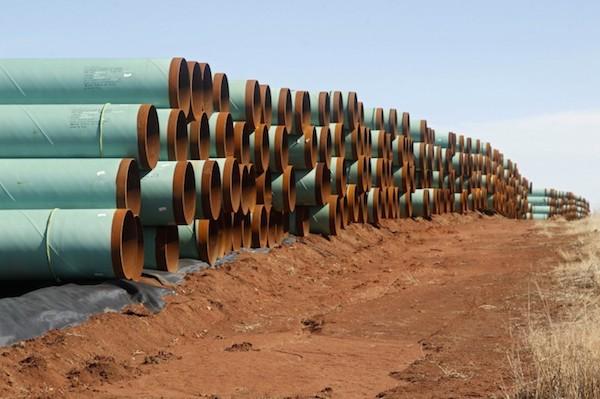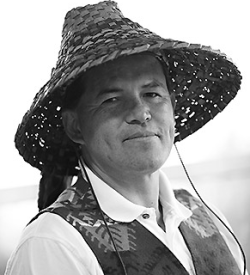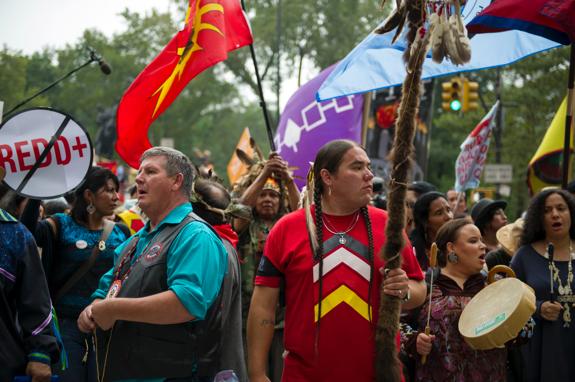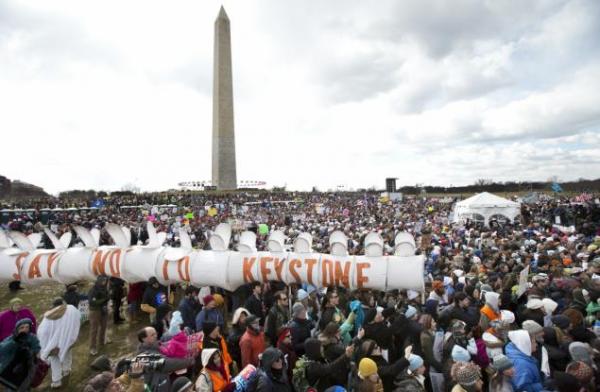The Rosebud Sioux are drawing on their ancient and spiritual connections to the land to try and prevent the incursion by Big Oil.
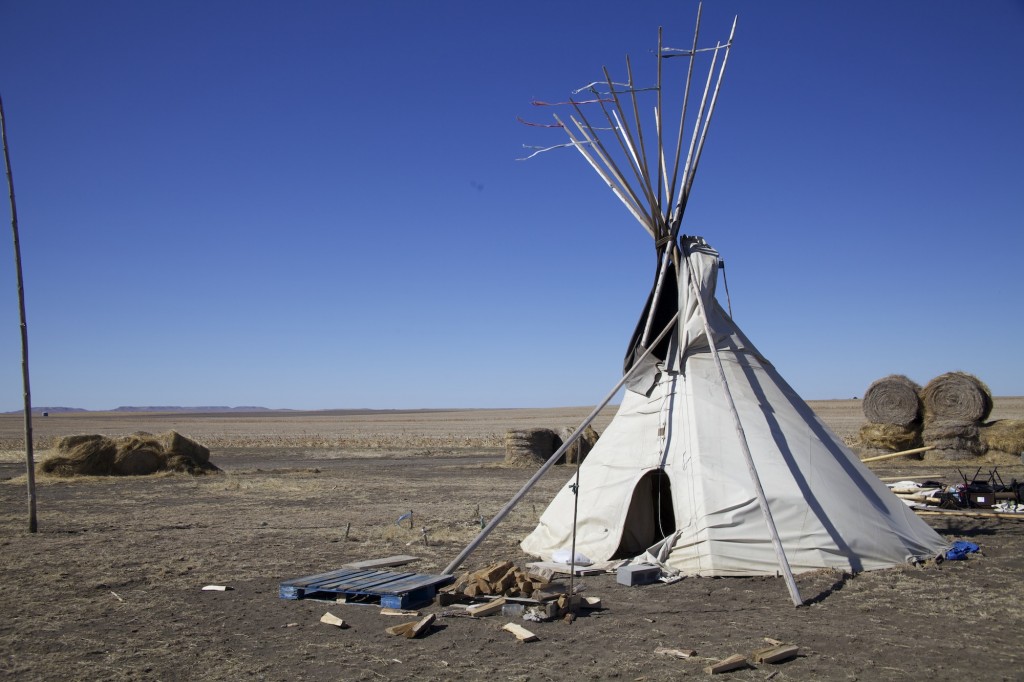
BY INDIA BOURKE, NewStatesman
The Dakotan sky is starting to blacken: “Something bad is coming this way; that wind came out of nowhere; something’s wrong, something’s very wrong,” a voice behind me warns. It’s almost midnight at the Rosebud Sioux Tribe’s “Spirit Camp” and the winds in the middle of the Great Plains are gusting alarmingly fast. “Are we OK out here?,” I shout above the flapping tents and flying debris, suddenly concerned that five teepees won’t give much shelter against the oncoming storm. The reassurance I am looking for is not forthcoming: “A prayer wouldn’t go amiss.”
In the Sioux’s Lakota mythology, Taku Skanskan, master of the four winds, is the herald of change (and of chaos). And on the first anniversary of this camp, built in opposition to the planned Keystone XL oil pipeline, its future is up in the air. Quite literally: by morning four of the five tents will lie shredded on the ground, and one camp member will be in hospital.
The proposed pipeline, or “Black Snake” as the Sioux call it, creeps ever closer. To Transcanada, the corporation behind it, these 1,179 miles of pipeline offer the most efficient method of connecting Canadian tar sands with oil refineries on the Gulf Coast. In Washington, it has become a political football, with Barack Obama vetoing a bill authorising the project in January. But big oil interests haven’t given up. Neither have Republicans, who have made building the pipeline a priority since taking control of Congress in last Autumn’s midterm elections. The assumption is that at some point it will be built.

“We’re protecting the future; for the people who can’t speak for themselves” – Gary Dorr, from the Nez Perce Tribe, Idaho.
Some suggest that its construction will make little difference to either job-creation, or to the overall extent of tar sands exploitation. For those who live in the pipeline’s path, however, it could change everything. None more so than the Native American tribes in South Dakota: perhaps America’s most downtrodden and overridden community.
To the Rosebud Sioux, the pipeline’s threat strikes deep. Its route, they argue, poses an untenable risk to their water supply. The lack of consultation from Transcanada is an affront to their ancient rights. Its exploitation of tar sands is an environmental curse on us all. In the words of their spiritual leader, Leonard Crow Dog (“God-Worcs”), such a pipeline would not just pollute the earth but risk leaving an entire generation “sterilised in their minds and in the conscience of their souls”.
For the last year therefore, a dedicated group of tribes-people have taken part in a continuous stakeout. Nestled within the sweeping Dakotan plains, at one of the few points where the pipeline would run near Indian land, lies a small circle of five white teepees. Only in America would the nearest named location to somewhere so remote be a place called “Ideal”. But to many anti-pipeline activists across the region – and the world – this unlikely camp has become just that: the ideal emblem of their fight.

It’s a responsibility that that weighs heavily on one of the spirit camp’s founders, Russell Eagle Bear (pictured above). After 365 days of ensuring that the camp stayed occupied – through wind, and cold, and heat, and spiders (“Oh my God the spiders!”) – he seems tired out. With furrowed brow and slow words, he explains the personal cost of keeping up the battle:
“There were times when we only had one person sitting out here… and now we’re at a time when I would like to think that we need a breather because it’s been an ongoing struggle I tell you; I get criticised all the time, I get threatened all the time.”
Some say he should personally have spent more time at the camp. Others that the camp should be taking the fight more literally:
“There are many, many people that come here who want us to pick up guns; y’know the pipeline hasn’t even started and yet they want me to sit out here with guns and things!”
Sometimes he feels as if he’s dealing with “big babies”. Yet he is also the first to acknowledge the personal transformations the camp has brought about for many from the community. Leota Eastman-Ironcloud describes her experience as nothing short of a “re-birth”. “She was here from day one,” Eagle Bear says with a fatherly pride. “Of course she has to go home and wash clothes and take care of business but she was constantly out here. And for a Lakota woman to stand up and defend us on our tribal land, that’s awesome; that’s so awesome it’s beyond words.”
Leota’s life has not been an easy one. Like many on the reservation where she was born and raised her three children, she has been touched by the hardship which characterizes Rosebud life. Located in the nation’s second poorest county, unemployment here hovers near 80 per cent and life expectancy is around 30 years lower than the American average. It’s a situation in which drug abuse, diabetes and alcoholism are rife, and suicide is epidemic. At breakfast one teenager turns up fresh from a night in the reservation’s jail. He’d been caught driving before the term of his drink-driving ban had ended. But he’s surprisingly buoyant: today marks a year of staying sober – a resolution made the day the tents went up.
This kind of reaction was an ambition for the camp’s founders from the start. From the outset, the Rosebuds’ response to the proposed Keystone XL pipeline has been resolutely spiritual. “[Our elders] say that with prayer you can stop this thing,” Eagle Bear explains. It’s a decision that seems to have worked on a number of levels. One member even believes it has helped keep the anti-terrorism agencies at arm’s length, though says she can still “hear them click on and off when I call my grandmother”.

Paula Antoine, chair person of the Oyate Wahacanka Woecun – Shielding the People, a project of the Rosebud Sioux Tribe.
Yet the camp’s symbolic power is turning in a new direction. Pipeline opponents across the country are increasingly being drawn into lengthy legal challenges – the Rosebud included. ‘We’re here to pray and we’ll continue doing that,” Eagle Bear assures the audience at the anniversary celebrations, “but we have to take that next step and deal with it in a legal way; using their courts, their laws and their courtrooms… We have the ability to do that as tribal people because this is our aboriginal land; this is our treaty land; this is our reservation boundary land”.
At a hearing commencing on 27 July, alongside three neighbouring tribal nations as well as the Dakota Rural Action and Bold Nebraska activist groups, the Rosebud will challenge TransCanada’s attempt to renew its state permit for the pipeline’s construction. Their argument focuses on what they deem to be an unacceptable threat to the region’s water supply. In particular, they cite the risk a spill would pose to the tribes’ own Mni Wiconi water pipeline, as well as to the vast Ogallala Aquifer (an underground system that currently supplies around two million people with clean water).
If this challenge fails, however, the tribes are readying themselves for an even bigger fight. This could involve a lawsuit against Transcanada and, if needed, the federal government itself. Gary Dorr of the Nez Perce Tribe in Idaho, explains that the threat to the water pipeline is “an infringement” of the tribes’ historic rights. Jen Baker, a Colorado-based lawyer who works with the Oglala Sioux Tribe, agrees: “It would be a violation of the federal trust responsibility to tribes for the federal government to allow that.”
Such a lawsuit would demand recognition of something called “treaty rights”. According to Dallas Goldtooth from the Indigenous Environmental Network, these rights “represent the acknowledgment that our tribal nations are more than just a ethnic minority; that we have inalienable rights to determine not only what happens to our people but also to mother earth”.
Under a peace treaty with the federal government in 1868, Sioux lands were defined in a vast swathe stretching from the Missouri River in Montana to Big Horn in Nebraska. Certain Native American rights to that land were enshrined in this treaty. Events of the twentieth century saw this territory increasingly divided into smaller, separate, reservations – with the land in between becoming the property of the state. Many argue, however, that native rights over this vacated land were not included in the transfer. Thus, although Transcanada has tried its best to route the pipeline around today’s reservations, it still passes directly over land said to be held “in trust”, on behalf of the Native American peoples.

Spiritual leader Leonard Crow Dog prepares for prayer.
There are many within the Rosebud community who know too well how far this trust has been abused over the years. Forty years ago, 76-year-old Leonard Crow Dog found himself sentenced for his political involvement with the American Indian Movement: “I fought for Indian rights and I went to penitentiary. I was sentenced for 23 years: scary,” he reminisces. The glee that the new understanding of Treaty Rights gives him, however, is tangible: “Lot of us didn’t know we owned all this land – we thought we owned Rosebud right there – now we have [rights across] millions of acres!”
Getting these rights recognized in court will be far from easy. Already the Rosebud are pressed to meet their legal defence needs and bring in expert witnesses. Just the other week it was ruled that testimony on tar-sand exploitation’s impact on climate change will not be allowed during the scheduled hearing next month, removing that element of their challenge.
There is some precedent for success though. In the early 1980s, the United States government acknowledged that the seizure of Black Hills territory violated the 1868 treaty. “They offered a money settlement to the tribal nations”, Goldtooth explains, but the tribes refused to take it: ‘“No we’re not going to take your blood money” they say, “We want the Black Hills back’’’.
Whether their challenge to Keystone XL stands or falls, arguments for a greater recognition of treaty rights look set to stay. From opposition to uranium mining and fracking to challenging the “unnecessary” placement of Native American children with white American foster families, many see the pipeline as “just the start” of a much wider battle.
It is one that could forge alliances not just across tribes, but countries. “We as native peoples have to get together now,” Eagle Bear exclaims. “Half a million native Mexicans up here with us – now wouldn’t that be something!”

Keith Fielder, Rosebud Sioux Tribe archeological monitor, surveys the wreckage after the storm.
Back at the camp, work is underway to rebuild after the storm. Despite the growing pressure the legal fight will put on people’s time and funds, the decision has been taken to keep the camp in operation, and to keep spirituality central to their cause.
During the day’s speeches, I admit I’d found the emphasis on prayer a little heavy. Yet lying in the dark that night, winds screaming above me, that scepticism thinned out. By the time I was helping clear up the debris the next morning it had gone. For many in this region the spirits, like the camp and the great Ogallala reservoir, are a connection that binds. “Even today, when you get that little soft wind, that’s the spirits responding, showing themselves; they’re coming through here,” Eagle Bear tells me. “It is a powerful time.” Taking on the power of Big Oil in America is no mean feat. The answer, perhaps, really is blowing in the wind.
All photos by India Bourke.


